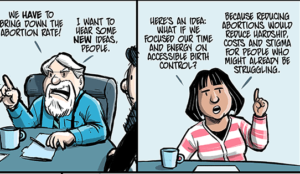ORANGE OVERFLOW
A LOOK AT THE EXPLODING U.S. FEMALE PRISON POPULATION
Panel 1
Text: International Prison Population Trends.
As of November 2013, more than 10.2 million people are held in penal institutions throughout the world.
The U.S. 2.2 million 0.69% of population
Russia 681,600 0.47% of population
Brazil 548,000 0.27% of population
China 1.7 million 0.13% of population
India 385,000 0.03% of population
As of June 2014, the United States has the second highest incarceration rate, with 707 prisoners per 100,000 of the national population.
Panel 2
Text: As of 2014, the U.S. has 1,719 state prisons, 102 federal prisons, 2,259 juvenile correctional facilities, 3,283 local jails.
U.S. is currently at 99% occupancy.
Panel 3
Text: Per capita cost of incarceration for all U.S. inmates $21,603 (2000) $29,291 (2013).
Appropriations for the bureau of prisons $3.7 billion (2000) $6.5 billion (2013).
Panel 4
Text: International Female Prison Population Trends
As of August 2012, more than 625,000 women and girls are held in penal institutions throughout the world
201,200 U.S.
84,600 China
59,200 Russia
35,596 Brazil
29,175 Thailand
Panel 5
Text: Since 2006 it has increased by more than 16%, with the largest increase in the Americas 23%, and the smallest increase in European countries 6%.
10%-15% – The proportion of females prosecuted is typically between 10% and 15% of total arrests.
10% – The percentage of females convicted is generally about 10% of total prosecutions.
The median proportion of females convicted is considerably lower than females prosecuted.
This could be explained by the fact that crimes committed by females tend to be less serious and thus have a greater chance to get a settle outside the court.
Panel 6
Text: Countries where most female prisoners are incarcerated for drug crimes
Estonia (46%), Sweden (41 %), Latvia (68%), Russia (33.7%), Italy (42.9%), Portugal (47.6%), Georgia (34%), Spain (45.5%), Greece (43.7%), Tajikistan (70%), Thailand (82%).
In some countries of Southeast Asia, drug trafficking results in long imprisonment or even death.
Panel 7
Text: U.S. Female Prison Population
2009 Females accounted for 12.1% (8,593) of federal offenders
2013 Females accounted for 13.3% (9,400) of federal offenders
Panel 8
Text:
2002: 66.2% Drug offenses, 16.1% property, 12.2% public order, 4.7% violence
2011: 57.0% Drug offenses, 17.3% property, 16.4% public order, 4.9% violence
2012: 57.9% Drug offenses, 18.8% property, 18.7% public order, 3.8% violence
2013: 33.7% Drug offenses, 23.9% fraud, 14.3% immigration, other
Panel 9
Text: The U.S. female prison population rate per 100,000 total residents
55.6 – 2001
66 – 2005
63.5 – 2010
64 – 2012
Panel 10
Text: The number of women in prison increased by 646%, 15118 (1980) – between – 112, 797 (2010).
As of 2012, female inmates make up 9% of the U.S. prison population.
Panel 11
Text: New Female Court Commitments to U.S. State Prison
1991 – 28,829
2001 – 39,428
2006 – 54,030
2011 – 47,383
Violent Crimes: 1991 – 16.5%, 2001 – 17.2%, 2006 – 15.8%, 2011 – 18.4%.
Between 1991 and 2011, fewer women were committed for violent crimes than men. Except for the decrease in 2006, the number of female violent offenders has been steadily increasing. The number of women admitted on new court commitments for violent offenses increased by 83%, from 4,756 in 1991 to 8,718 in 2011.
Property Crimes: 1991 – 35.7%, 2001 – 36.8%, 2006 – 36.2%, 2011 – 36.0%.
Between 1991 and 2011, more women were committed for property crimes than men. Except for the increase in 2001, the number of female property offenders has been slowly decreasing. The number of women that entered prison for property crimes decreased from 19,558 in 2006 to 17,057 in 2011.
Drug Crimes: 1991 – 40.9%, 2001 – 37.3%, 2006 – 34.2%, 2011 – 32.5%.
Between 1991 and 2011, more women were committed for drug crimes than men. Since 1991, the number of female drug offenders has been steadily decreasing. Between 1991 and 2001, drug crimes made up the majority of new women court commitments to state prison.
Public Order Crimes: 1991 – 5.6%, 2001 – 8.00%, 2006 – 13.1%, 2011 – 12.0%.
Between 1991 and 2011, fewer women were committed for public order crimes than men. The number of female public order offenders peaked in 2006 but decreased by 2011.
Panel 12
Text: Race in the U.S. female prison system
2012 U.S. Of 101,289 women sentenced to prison, 18.1% were aged 30 to 34 and nearly half (49,352) were white.
In 2012, black women aged 18 to 19 were three times more likely to be imprisoned than white women.
Hispanic women in this age group had imprisonment rates nearly twice those of white women.
Hispanic females aged 65 or older were more than twice as likely as white females of this age to be serving time in prison.
Panel 13
Text: Racial Groups
In 2013, more than one-third of female federal offenders were Hispanic (37.5%) followed by White (34.5%), Black (21.8%) and other races (6.2%)
Drug Trafficking Offenders
43.6% Hispanic, 35.6% White, 16.3% Black, 4.5% Other Races
Fraud Offenders
42.5% Hispanic, 35.8% White, 15.5% Black, 6.2% Other Races
Immigration Offenders
86.4% Hispanic, 5.4% White, 4.9% Black, 3.3% Other Race
Panel 14
Text: The average age of these offenders at sentencing was 38 YEARS. The majority of female offenders were U.S. citizens – 79.5%. 70.8% of female offenders had little or no prior criminal history.
49 female inmates under 18 years old. 3,862 female reported state and federal noncitizen inmates.
Panel 15
Text: FEMALE OFFENDERS VS. MALE OFFENDERS
75.6% General imprisonment rate 93.6%
4.1% Cases that involved weapons 8.6%
90.3% Drug trafficking rate 97.3%
61.1% Fraud offenses rate 74.1%
85.0% Immigration offenses rate 97.5%
Panel 16
Text: Conclusions (U.S.): 2011 – 2012
0.2% decrease in sentenced federal prisoners
1.4% .decrease in the female federal prison population
22.9% decrease in violent offenses
16.1% increase in property offenses
3.0% increase in drug offenses
9.3% increase in public order offenses
Panel 17
Text: Sources:
http://www.prisonstudies.org/highest-to-lowest/prison_population_rate?field_region_taxonomy_tid=AII
http://www.prisonstudies.org/highest-to-lowest/prison-population-total?field_region_taxonomy_tid=All
http://www.prisonstudies.org/highest-to-lowest/female-prisoners?field_region_taxonomy_tid=All
http://www.statista.com/statistics/262962/countries-with-the-most-prisoners-per-100-000-inhabitants/
http://www.prisonstudies.org/country/united-states-america
http://www.statista.com/statistics/252828/number-of-prisoners-in-the-us-by-gender/
http://www.census.gov/popclock/
http://www.bjs.gov/content/pub/pdf/p12tar9112.pdf
http://fas.org/sgp/crs/misc/R42937.pdf
http://www.prisonpolicy.org/reports/pie.html
http://www.ussc.gov/sites/default/files/pdf/research-and-publications/quick-facts/Quick_Facts_Female_Offenders.pdf
http://www.prisonstudies.org/sites/prisonstudies.org/files/resources/downloads/wfil_2nd_edition.pdf
http://www.prisonstudies.org/sites/prisonstudies.org/files/resources/downloads/wppl_10.pdf
http://www.sentencingproject.org/doc/publications/cc_lncarcerated_Women_Factsheet_Sep24sp.pdf
http://www.unodc.org/documents/data-and-analysis/Crime-statistics/lnternational_Statistics_on_Crime_and Justice.pdf
http://www.ihra.net/files/2012/03/11/HRI_WomenlnPrisonReport.pdf
http://www.thaiprisonlife.com/thai-prison-statistics/
http://www.unafei.or.jp/activities/No90_13VE_Chitsawang.pdf
Boston University
http://cjdegreeonline.bu.edu/





















